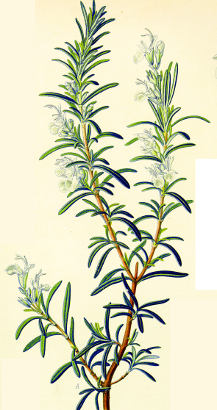 Rosmarinus
officinalis
Rosmarinus
officinalisRosemary
Perhaps recognizing the protective properties of this magic herb, ancient Romans bordered their gardens with rosemary, and Arabs grew clipped rosemary hedges around their rose gardens. In medieval Europe, a branch under the bed warded off bad dreams and evil spirits (not to mention fleas). Rosemary was grown in monastery gardens throughout Europe and became an ingredient in medicinal liqueurs like Chartreuse. An influsion of the leaves in white wine was a treatment for coughs, and it was also an ingredient, along with myrtle and lavender, in the original Queen of Hungary water, which was created as a medicinal rub for paralysis (simply infuse equal parts in brandy). Combined with juniper berries, rosemary makes a nice-smelling disinfectant for the air and incense for purification. Dry some sprigs for a few days and then tie them in a bundle to make a European smudge stick. In the Eastern Orthodox Church, rosemary is used for asperging and to dress icons.
Rosemary has been involved
in both funerary rites and love magic. In France, rosemary was placed
in the hands of the dead. In England, because people believed that
rosemary strengthened memory and its leaves are evergreen, it was the
herb of remembrance--remembering, for instance, a love from which one
is parted or the beloved dead. But rosemary's connection with memory
goes back to ancient Greece, where students sniffed it to help them in
their studies. Showing the sort of ambiguousness people feel towards
witchcraft, according to American  folklore, the real witch Grace Sherwood of Virginia supposedly brought
rosemary to America (Sherwood was convicted of witchcraft in 1706 but
at some point was released from imprisonment and went on to own a large
farm, which she left to her son when she died of natural causes at age
80). Probably because it is evergreen and so would be one of the few
herbs growing in winter in much of Europe, rosemary is associated with
celebrations of Winter Solstice. In much of North America,
however, winters are generally too cold for rosemary to live outside.
According to the poet Ovid, the female centaur Hylonome plaited
rosemary in her hair. Rosemary is nice mixed with lavender, roses, and mugwort for a dream
pillow, or use the leaves to stuff a poppet meant for
healing. A rosemary tea is made for headaches (typical Mercury
work), and this magic herb is goes into calming, purifying, or
protective baths.
folklore, the real witch Grace Sherwood of Virginia supposedly brought
rosemary to America (Sherwood was convicted of witchcraft in 1706 but
at some point was released from imprisonment and went on to own a large
farm, which she left to her son when she died of natural causes at age
80). Probably because it is evergreen and so would be one of the few
herbs growing in winter in much of Europe, rosemary is associated with
celebrations of Winter Solstice. In much of North America,
however, winters are generally too cold for rosemary to live outside.
According to the poet Ovid, the female centaur Hylonome plaited
rosemary in her hair. Rosemary is nice mixed with lavender, roses, and mugwort for a dream
pillow, or use the leaves to stuff a poppet meant for
healing. A rosemary tea is made for headaches (typical Mercury
work), and this magic herb is goes into calming, purifying, or
protective baths.
How to Grow Rosemary
Barely cover
seeds to germinate in 2-3 weeks at room temperature. Typical
germination rates for rosemary seeds are 30-50%. The seeds don't live a
long time, so plant them within a few months of buying them. Sow in spring and set out as transplants to full
sun in spacing of 8-24" in warm, dry soil, preferably on the limey side
or having some rocks. This is a Mediterranean native, so it enjoys
rocky soil and dry warm. It's a great candidate for growing in a pot by
the door, because it's wonderful to brush your hands along it to
collect the fresh scent as you go in and out. Rosemary gets 36-48 in. (90-120
cm) tall. It is hardy down to 0F/-18C but can be brought
through a zone 6 winter if it is mulched and doesn't get too wet.
Rosemary can also be propagated from cuttings. General
growing info
Rosmarinus
officinalis
Rosemary
100 seeds $3.75
Uses in Witchcraft & Magic:
Purification
Protection from Nightmares & Evil Spirits
Funerary Rites
Love Magic & Weddings
Healing Spells
Animal Magic
Mercury Herb
Get some dried rosemary
© 2010-2024 Alchemy Works; No reproduction without permission